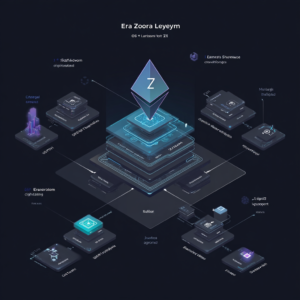
A16z & DeFi Ed. Fund Suggest ‘Safe Harbor’ for DeFi Apps – Blockworks
Unpacking a16z and DeFi Education Fund's ‘Safe Harbor’ Proposal: A Shield for DeFi Apps
In the wild, wild west of decentralized finance (DeFi), where the rules are still being scribbled down on the back of napkins, two players – Andreessen Horowitz (commonly known as a16z) and the DeFi Education Fund – have stepped into the ring. They’re throwing a lifeline in the form of a comprehensive "safe harbor" framework aimed squarely at the U.S. Securities and Exchange Commission (SEC), hoping to provide some much-needed clarity and protection for those ingenious DeFi applications and non-fungible token (NFT) marketplaces that’ve been playing hot potato with regulatory scrutiny.
What this proposal aims to do is revolutionary: it seeks to carve out exceptions for certain DeFi apps—specifically those that are non-custodial and decentralized—from being slapped with broker-dealer registration and enforcement requirements that make it feel like they’re constantly walking on eggshells. Who wants that kind of pressure when all you want is to innovate, right?
The Regulatory Quagmire: Are We There Yet?
If we peek behind the curtain of today's regulatory landscape, we find ourselves in a murky swamp where many blockchain applications can’t quite find their footing. While the decentralized foundations are often treated with a wink and a nod as outside the grasp of broker-dealer regulations (thankfully), the applications built around them? Well, that’s a whole different story. Those apps, usually dreamed up and maintained by centralized teams, risk being classified as brokers faster than you can say "compliance violation."
The past is littered with SEC enforcement actions and Wells notices—those ominous letters that indicate potential liabilities for developers. A16z and the DeFi Education Fund are waving their flags, claiming that this uncertainty is contrary to the core essence of broker-dealer regulations which are primarily designed to target centralized entities pulling the strings in transactions, custody of assets, or dishing out investment advice.
Four Pillars of Safety: What Makes the Cut?
Now, if these DeFi apps want to glide into the safe zone, they’ll need to meet four demanding criteria that ensure they don’t operate like your average broker. Here’s where the rubber meets the road:
-
Decentralized Protocols: The app’s underlying blockchain network must be a true maverick, genuinely decentralized and autonomous—no puppet strings tied to a centralized entity here.
-
Non-Custodial: This is a biggie. The app can’t be hoarding or controlling users’ funds; they have to have full custody of their assets at all times. Just like a good parent, you gotta let the kid have their toys.
-
No Investment Recommendations: No whispering sweet nothings about personalized investment advice. This isn’t a dating app looking to match users with their financial soulmate.
-
No Discretionary Control: The app should not be making decisions on behalf of its users—think of it as a tool workbench for self-execution of transactions, not a bossy overseer.
If DeFi applications can strut the secure walk of these principles, they’ll leave behind the risks that broker-dealer regulations target, rendering broker registration as unnecessary as a floppy disk in a cloud-based world.
Impact on Developers and the Crypto Ecosystem: The Good, The Bad, and the Innovative
What’s all this hoopla really about for developers? The proposal is designed to play nice and foster innovation, providing a legal cushion for those crafting DeFi applications in the bustling land of the U.S. In absence of clear regulatory maps, developers are left tiptoeing through a minefield of potential enforcement actions—a constant source of headache since the existing regulations often seem to be made with a different type of technology in mind.
Amanda Tuminelli, the Executive Director of the DeFi Education Fund, has pointed out the urgent need for clarity to prevent the inappropriate misapplication of legal categories on modern software infrastructures. Think of it as sounding the alarm on outdated logic in a fast-paced world. This proposal hopes to create safe passage for non-custodial apps like wallets (think Coinbase Wallet), DeFi protocols (like Uniswap), and NFT platforms (such as OpenSea), all while keeping them from being misclassified as brokers.
Meeting in the Middle: SEC’s Evolving Playbook
Intriguingly, this initiative isn’t just a fork in the road; it aligns with the SEC’s ongoing attempts under Chair Paul Atkins and Commissioner Hester Peirce, who have been signaling a desire to modernize crypto regulations. Look no further than their brainstorming project dubbed “Project Crypto,” which aims to refresh regulations so they fit the wild character of digital assets better than a bespoke suit fits a movie star.
While this proposal stops short of directly dealing with past SEC enforcement actions against centralized exchanges like Coinbase or Kraken, it represents a budding attempt to balance the scales of investor protection and the imperative to maintain the United States' shining star status in blockchain innovation.
The Ripple Effect: What Does This Mean?
So what can we expect if this proposal becomes the new norm?
-
A Regulatory Blueprint: The safe harbor could serve as a model for how regulators sift through the messy lens of decentralized, non-custodial apps vis-a-vis defined broker obligations. It could help erase significant legal uncertainties—imagine the relief!
-
Boosting DeFi and NFT Innovation: By easing anxiety right off the bat through regulatory comfort, we could potentially see a spirited development and adoption surge of DeFi and NFT products.
-
SEC Authority Remains in Play: The proposal wisely preserves the SEC’s authority to manage high-risk activities, ensuring that actual bad actors or custodial intermediaries don’t escape their due oversight. That’s just common sense.
-
Watching Closely: Eyes will be glued to how the SEC responds and what the final regulatory decisions will entail. The outcome of this proposal may shape the U.S. regulatory landscape for crypto in ways we can't even imagine yet, with possible reforms on the calendar for as early as 2026.
Get Informed: Dig Deeper into the Proposal
For those keener than a detective on a mission, you can dive into the full safe harbor proposal crafted by a16z and the DeFi Education Fund. It’s packed with a detailed rationale and specific eligibility conditions.
And if you're on the hunt for continual insights and all the latest scoops, platforms like Blockworks and Coinpedia are your go-to hotspots for updated coverage.
Want to stay up to date with the latest news on neural networks and automation? Subscribe to our Telegram channel: @channel_neirotoken
In conclusion, the intersection of decentralization and regulation is fraught with complexities. This new proposal aims to outline a path forward, blending innovation and compliance. Pretty exhilarating, don’t you think?

